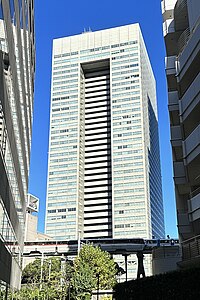
Photo from wikipedia
Multielectronic reaction electrode materials for high energy density lithium-ion batteries (LIBs) are severely hindered by their inherent sluggish kinetics and large volume variations, leading to rapid capacity fade. Here, a… Click to show full abstract
Multielectronic reaction electrode materials for high energy density lithium-ion batteries (LIBs) are severely hindered by their inherent sluggish kinetics and large volume variations, leading to rapid capacity fade. Here, a simple method is developed to construct low-carbon and nanosheathed ZnCo2O4 porous spheroids (ZCO@C-5). In this micro/nanostructure, an ultrathin amorphous carbon layer (~2 nm in thickness) is distributed all over the primary nanosized ZCO particles (~20 nm in diameter), which finally self-assembles into porous core (ZCO)-shell(carbon) micron spheroids. The nanoencapsulation and macro/mesoporous architecture can not only provide facile electrolyte penetration and rapid ion/electron transfer but also better alleviate volumetric expansion effect to avoid pulverization of ZCO@C-5 spheroids during repeat charge/discharge processes. As expected, the three-dimensional porous ZCO@C-5 composites exhibit high reversible capacity of 1240 mAh g−1 cycle at 500 mA g−1, as well as excellent long-term cycling stability and rate capability. The low-carbon and nanoencapsulation strategy in this study is simple and effective, exhibiting great potential for high-performance LIBs.
Journal Title: Research
Year Published: 2019
Link to full text (if available)
Share on Social Media: Sign Up to like & get
recommendations!